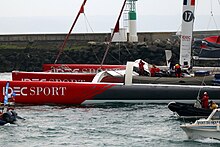
The first around the world sailing record for circumnavigation of the world can be attributed to the surviving crew of Ferdinand Magellan's expedition, including the last captain Juan Sebastián Elcano who completed their journey in 1522.
Although not in a single voyage but Magellan was technically the first to circumnavigate the globe since he was killed in the Mactan Islands and while in the Kingdom of Portugal's service, Magellan had already reached the Malay Archipelago in Southeast Asia on previous voyages traveling east (from 1505 to 1511–1512). By visiting this area again but now traveling west, Magellan achieved a nearly complete personal circumnavigation of the globe for the first time in history.[1][2]
The first solo record was set by Joshua Slocum in the Spray (1898). The current record holders are IDEC 3, skippered by Francis Joyon in 40 days, 23 hours, 30 minutes and 30 seconds for a crewed journey, and François Gabart with Macif in 42 days, 16 hours, 40 minutes and 35 seconds for a solo journey.
Most races or solo attempts start from Europe. Due to the configuration of the continents, sailing around the world consists of sailing on the Southern Ocean around the Antarctica continent, passing south of Cape Horn, Cape of Good Hope and Cape Leeuwin. Since 1918 the Panama Canal is an option but the locks must be entered and exited using engine power. Large stretches of the canal can be crossed under sail power.
Sailing around the world can be done by two directions: eastward or westward. The dominant winds and currents (outside tropical areas) make the voyage eastwards on the Southern hemisphere faster, most skippers and yachts who race prefer this route. Today, the multihulls perform much better than monohulls and hold the best times. Leisure yacht skippers who prefer tropical seas more often go westward, using the trade winds (and the Panama Canal). The Jules Verne Trophy is awarded for the fastest qualifying circumnavigation, starting from an imaginary line between the Créac'h lighthouse on Ushant island, France, and the Lizard Lighthouse, UK.
The records are homologated by the World Sailing Speed Record Council (WSSRC).[3] WSSRC rules state that qualifying round-the-world voyages must be at least 21,600 nmi long, calculated along the shortest possible track from the starting port and back that does not cross land and does not go below 63°S. The great-circle distance formulas are to be used, assuming that the great circle length is 21,600 nmi. It is allowed to have one single waypoint to lengthen the calculated track. The equator must be crossed.[4] In reality, this means that the boat should pass a waypoint at or not far from the antipode of the starting port of the journey (the exact position depends on how short the shortest possible track is). For example, the Vendée Globe starts at 46°N 2°W, has a waypoint at 57°S 180°E, and barely makes the distance requirement. The participants don't have to go to the antipode at 46°S 178°E since the rounding of Africa gives extra distance.
- ^ Miller, Gordon (2011). Voyages: To the New World and Beyond (1st ed.). University of Washington Press. p. 30. ISBN 978-0-295-99115-3.
- ^ Dutch, Steve (21 May 1997). "Circumnavigations of the Globe to 1800". University of Wisconsin-Green Bay. Archived from the original on 23 October 2014. Retrieved 11 October 2014.
- ^ "round the world records". Archived from the original on 27 September 2011.
- ^ "The courses offshore". www.sailspeedrecords.com.